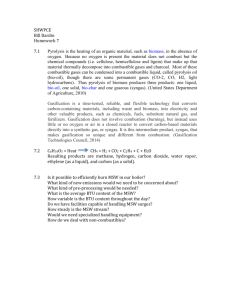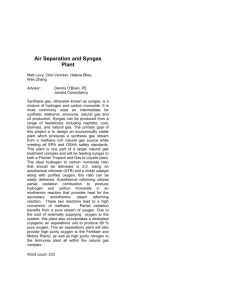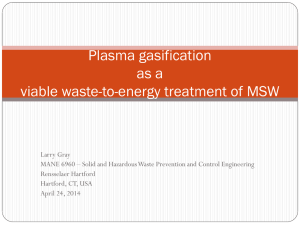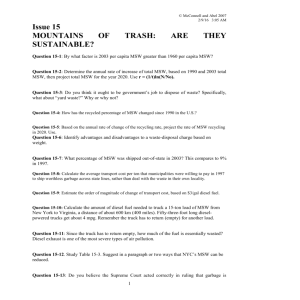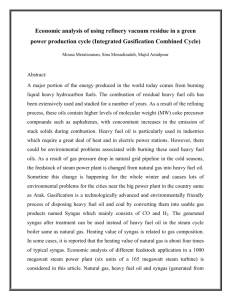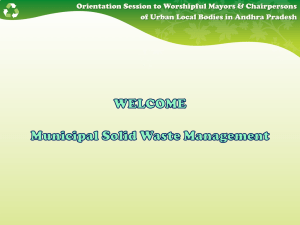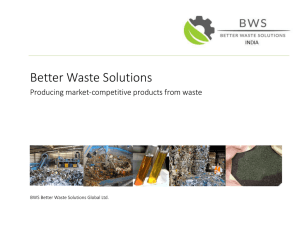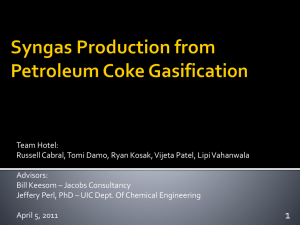Waste to energy - Weizmann Institute of Science
advertisement
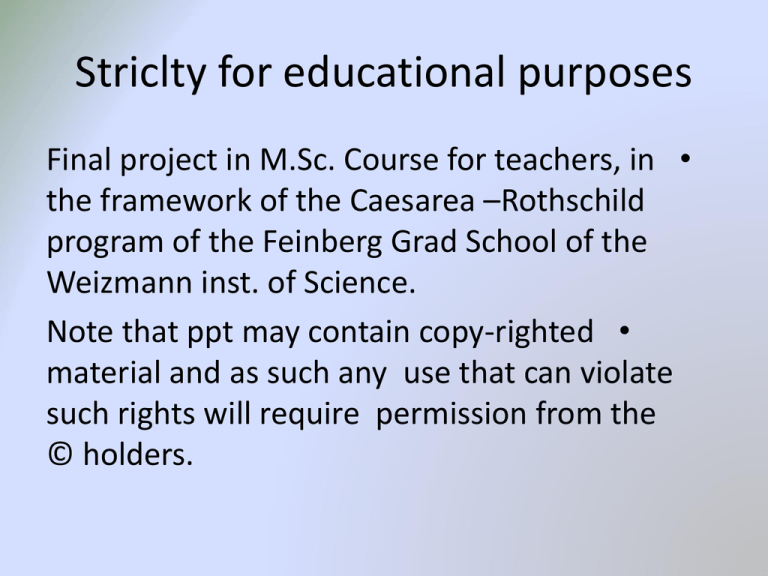
Striclty for educational purposes
Final project in M.Sc. Course for teachers, in •
the framework of the Caesarea –Rothschild
program of the Feinberg Grad School of the
Weizmann inst. of Science.
Note that ppt may contain copy-righted •
material and as such any use that can violate
such rights will require permission from the
© holders.
Waste to Energy
via Syngas (synthetic gas) production
and Fischer –Tropsch biodiesel
Ben Osher
How much diesel can be produced from solid waste in Israel ?
Why Use Waste?
• As the amount of fossil fuels available
decreases and the cost of petroleumbased fuels increases, there is a need for
alternative fuel sources.
• A promising process for green-fuel and
electricity production involves the
formation of SYNGAS which can be
converted to useful fuel and other
organic materials.
What is syngas?
Abbreviation of “synthetic gas”.
It can be the end product of thermally processed biomass
the main compounds in syngas are:
* Carbon monoxide : CO
* Hydrogen: H2
Other by-products:
* Carbon dioxide: CO2
* Methane: CH4
What can be done with syngas?
Gasification
waste
Syngas
Fischer-Tropsch GREEN
DIESEL
Waste treatment: OLD vs. reNEWable
Dealing with waste - Questions to be asked:
• How much waste is there to be treated?
• What type of waste is to be treated?
For example does it contain just MSW or does it
include commercial waste, sewage sludge , tyres
etc.?
• What are the characteristics of the waste in terms
of chemical composition, caloric value, particle size,
moisture etc.?
Municipal Solid Waste
MSW
BIOGENIC
NON-BIOGENIC
such as food waste
and yard clippings
such as plastics and metals
http://www.eia.gov/todayinenergy/detail.cfm?id=8010
Municipal Solid Waste
With time the biogenic portion of municipal solid waste decreases;
Because non-biogenic waste has a higher heat content than biogenic material
the average heat content of MSW (per unit mass) as a whole is increasing,
making it a more efficient fuel for producing electricity .
http://www.eia.gov/totalenergy/data/monthly/pdf/historical/msw.pdf
Israel: waste facts
•
•
•
•
4.9 million ton of MSW is produced each year.
Average waste/person/day 1.9 (3-5% growth)
~20% of MSW is recycled => ~ 1.5 kg/day/person to landfills
Total fuel consumption for private transportation is 5.35109
http://www.sviva.gov.il/subjectsEnv/Waste/Policy/Documents/waste_management.pdf
l
year
Thermal waste treatment
Thermal waste
treatment
Combustion
rapid oxidation of a
feedstock as it
is exposed air .
heat in a boiler
where steam, under
high pressure, is
passed through a
turbine which
powers a generator
pyrolysis
gasification
Thermal degradation
of waste in the
absence of air to
produce char, oil,
and syngas.
e.g. wood to
charcoal
Breakdown of
hydrocarbons into
syngas by controlling
the amount of
oxygen during
burning.
3000 C 6000 C
~ 14000 C
7000KPa
Gasification: Main chemical reactions
Within a gasification process the major chemical reactions are those involving
carbon, CO, CO2, water (steam) and methane, as follows:
First step: steam
CH 4 H 2O CO 3H 2
C H 2O CO H 2
H 205 .9
H 122 .6
kJ
mol
kJ
mol
Endothermic reactions
Methane needed comes from
C 2H 2 CH 4
Second step: air /o2
CO O2 CO2
1
H O2 H 2O
2
kJ
m ol
kJ
H 241.1
m ol
H 401.9
Third step:CO formation
C CO2 2CO
H 164 .9
kJ
mol
Exothermic reactions
Fischer-Tropsch Synthesis
The process involves a series of chemical reactions
that produce a variety of saturated hydrocarbons
It uses Iron- or Cobalt-based catalysts
CO 2H 2 catalyst
CH 2 H 2O
Professor Franz Fischer (left)
and Dr Hans Tropsch
H2
2
CO
When the H2/CO ratio in the feed gas is lower, it can be adjusted with the
water gas shift reaction to use the component in excess to yield the missing one:
CO H 2O CO2 H 2
FT Chemical mechanism:
Overall process: waste in - no waste out
Overall process: Hypothetical energy recovery
MSW conversion and synthesis to F-T products with heat recovery
can make beneficial and commercial use of 71%.
Calculations:
kWh
;
l
MWh
~5
t
MWh
MWh
l
0.71 5
/{0.011
} 323
t
l
t
11
~ 1106
t
year
t
l
l
8
110
323 3.2310
year
t
year
6
Diesel energy density
Av. energy value of MSW
Amount of diesel
Part of MSW for thermal treatment
in Israel
Amount of diesel produced
Conclusions:
FT diesel assumed to be 7.19 $/bbl (~0.16 )שקל לליטר
more expensive than transportation fuels derived from
crude oil. Choi & al, 2011
A ton of MSW with average energy content of ~5
can yield up to: 323 liters of ultra clean Diesel fuel.
MWh
t
F-T fuels can replace 6% of total fuel consumption in Israel!
Advantages ( if goals are achieved)
• Reduction of municipal and industrial
waste disposal.
• Reduction of CO2 emissions from
incineration.
• Use of renewable low cost feedstocks
• Converting waste into ultra clean-diesel.
• Use of sustainable methods to convert
waste into useful products
By treating our wastes we do not only do
good for the environment but also good
business for the local- and global economy.
